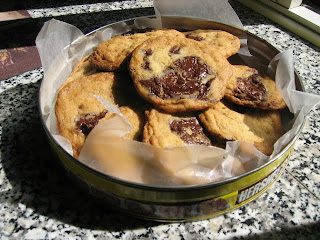
Okay, before we begin today's post, I have some breaking news: I AM TAKING A MASTER CLASS WITH DORIE GREENSPAN! Yes, you read that correctly. Quake with jealousy.
Turns out that Dorie Greenspan's son went to our high school and graduated two years ahead of Rebecca, and she's doing a free master class for Dalton alumni. Don't know why, don't care why, but when Rebecca called me and told me the exciting news, I signed up immediately! Now I am counting the minutes until 10:00 on November 7th, when I will be meeting our muse/idol/hero/[your creepy noun of choice here.] Sadly, Rebecca won't be there, for obvious reasons, but I will take pictures and get autographs up the wazoo, so never fear.
And now, back to our regularly scheduled programming.
Our mom is a great lady. She is always there for us. She also works, and has been a great role model on how to balance work and family. (Or as she says: "I love you girls, but if I had had to stay home with you all day, I would have killed myself.") Anyway, I had this big problem with my housing. It's a long, sad story but the crux of it is that Brown University Office of Residential Life can suck it. Mommy was really helpful throughout the whole ordeal and it all worked out in the end (mostly). So in honor of her being the best mother, I thought I should make her the best chocolate chip cookies.
For those of you who somehow missed this - shame on you - the New York Times did a highly scientific search for the perfect chocolate chip cookie. They eventually settled on a Jacques Torres recipe. We're lucky enough to have a Jacques Torres location less than half a mile away, but I had never made the recipe because it seemed too fussy, what with its two types of flour, specifically shaped chocolate disks and minimum 24-hour chilling time. In my mind, chocolate chip cookies just should not be that high-maintenance. However, for my mother I was willing to try.
I admit, I didn't follow the recipe completely. I subsituted all-purpose flour for the bread flour and an all-purpose flour/cornstarch mix for the cake flour (my go-to substitution is 1 cup minus 2 tablespoons of flour plus two tablespoons of cornstarch- it seems to work well, something about the gluten blah blah blah). I also just used chopped-up Ghirardelli chocolate instead of the disks. This might have been a mistake, since the chocolate melted sort of strangely and spread out in a way that was somewhat unattractive, though still tasty. Lastly, I only chilled the dough for 21 hours, because I needed to make the cookies before my mother got home. Sue me. However, I do hear that you should chill for 36 hours to get the optimal interplay of flavors that the chilling is supposed to achieve. Maybe next time.
So in sum, I pretty much eliminated or mitigated everything that makes this cookie distinctive/fussy. And was it still the perfect chocolate chip cookie? No, probably not, though it was pretty darn good. The chilling really does bring out certain flavors, like the molasses in the brown sugar, that are otherwise hidden. My tip for you should you attempt the recipe is to space out the cookies widely, because they spread like crazy and bleed together. My question for you is: Do you have any strategies for how to add the salt? Reading about these cookies was the first time I realized the potential of salt in baked goods, but when I just sprinkled it on some of the cookies had way too much salt and some had way too little. Something to think about for next time I decide I want to make 36-hour cookies.
Recipe (from the New York Times Website)
1 2/3 cups (8 1/2 ounces) bread flour
1 1/4 teaspoons baking soda
1 1/2 teaspoons baking powder
1 1/2 teaspoons coarse salt
2 1/2 sticks (1 1/4 cups) unsalted butter
1 1/4 cups (10 ounces) light brown sugar
1 cup plus 2 tablespoons (8 ounces) granulated sugar
2 large eggs
2 teaspoons natural vanilla extract
1 1/4 pounds bittersweet chocolate disks or fèves, at least 60 percent cacao content (see note)
Sea salt.











